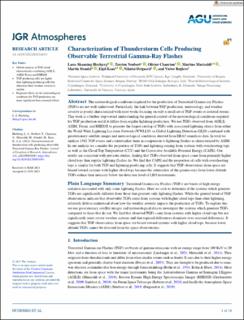| dc.contributor.author | Husbjerg, Lasse Skaaning | |
| dc.contributor.author | Neubert, Torsten | |
| dc.contributor.author | Chanrion, Olivier | |
| dc.contributor.author | Marisaldi, Martino | |
| dc.contributor.author | Stendel, Martin | |
| dc.contributor.author | Kaas, Eigil | |
| dc.contributor.author | Østgaard, Nikolai | |
| dc.contributor.author | Reglero, Victor | |
| dc.date.accessioned | 2023-12-15T13:18:48Z | |
| dc.date.available | 2023-12-15T13:18:48Z | |
| dc.date.created | 2023-10-13T12:54:44Z | |
| dc.date.issued | 2023 | |
| dc.identifier.issn | 2169-897X | |
| dc.identifier.uri | https://hdl.handle.net/11250/3107825 | |
| dc.description.abstract | The meteorological conditions required for the production of Terrestrial Gamma-ray Flashes (TGFs) are not well understood. Particularly, the link between TGF production, meteorology, and weather severity is poorly characterized with most works focusing on only a small set of TGF events or isolated storms. This work is a further step toward understanding the general context of the meteorological conditions required for TGF production and if it differs from regular lightning production. We use TGFs observed from AGILE, ASIM, Fermi, and RHESSI to generate the largest catalog of TGFs with associated lightning sferics from either the World Wide Lightning Location Network (WWLLN) or Global Lightning Detection (GLD) combined with geostationary satellite images and meteorological conditions derived from ERA5 reanalysis data. In total we analyze 1582 TGF events and contextualize them in comparison to lightning flashes as characterized by ASIM. In our analysis we consider the proportion of TGFs and lightning coming from systems with overshooting tops as well as the Cloud Top Temperature (CTT) and the Convective Available Potential Energy (CAPE). Our results are consistent with previous studies, finding that TGFs observed from space come from primarily higher cloud tops than regular lightning flashes do. We find that CAPE and the proportion of cells with overshooting tops is similar for both TGF and lightning producing cells. It suggests that TGF observations from space are biased toward systems with higher cloud tops because the attenuation of the gamma-rays from lower altitude TGFs reduce their intensity below the detection level of LEO instruments. | en_US |
| dc.language.iso | eng | en_US |
| dc.publisher | AGU | en_US |
| dc.rights | Navngivelse-Ikkekommersiell 4.0 Internasjonal | * |
| dc.rights.uri | http://creativecommons.org/licenses/by-nc/4.0/deed.no | * |
| dc.title | Characterization of Thunderstorm Cells Producing Observable Terrestrial Gamma-Ray Flashes | en_US |
| dc.type | Journal article | en_US |
| dc.type | Peer reviewed | en_US |
| dc.description.version | publishedVersion | en_US |
| dc.rights.holder | Copyright 2023 The Author(s) | en_US |
| dc.source.articlenumber | e2023JD038893 | en_US |
| cristin.ispublished | true | |
| cristin.fulltext | original | |
| cristin.qualitycode | 2 | |
| dc.identifier.doi | 10.1029/2023JD038893 | |
| dc.identifier.cristin | 2184458 | |
| dc.source.journal | Journal of Geophysical Research (JGR): Atmospheres | en_US |
| dc.identifier.citation | Journal of Geophysical Research (JGR): Atmospheres. 2023, 128 (17), e2023JD038893. | en_US |
| dc.source.volume | 128 | en_US |
| dc.source.issue | 17 | en_US |

